Nedap N V TDC Deactivator User Manual TDC V1 20
N. V. Nederlandsche Apparatenfabriek NEDAP Deactivator TDC V1 20
Contents
- 1. user manual
- 2. User Manual 1
- 3. User Manual 2
user manual

Date: 29 April 2004 Version 1.20
This information is furnished for guidance, and with no guarantee as to its accuracy or completeness; its publication conveys no license under any patent or other right, nor does
the publisher assume liability for any consequence of its use; specifications and availability of goods mentioned in it are subject to change without notice; it is not to be
reproduced in any way, in whole or in part, without the written consent of the publisher.
_________________________________________________________________________________________________________
© Nedap Retail Support P.O. Box 102 NL-7140 AC Groenlo the Netherlands
Installation Sheet
- TDC

2
TDC 2004 V1.20 | Nedap Retail Support
- support-rs@nedap.com
- H. Hammer
+31 (0) 544-47 15 19
hans.hammer@nedap.com
- H. Broekhuis
+31 (0) 544-47 15 02
han.broekhuis@nedap.com
Visitor’s address:
Nedap Retail Support
Parallelweg 2d
Groenlo
Netherlands
Postal address:
Nedap Retail Support
Postbus 102
7140 AC Groenlo
Fax
+31 (0) 544-46 58 14
© 2004 Nedap Retail Support - Netherlands
Parallelweg 2d, 7141 DC Groenlo
The software / hardware described in this book / file is furnished under a license agreement and may be used only in accordance with the terms of
the agreement.
Documentation version 1.20
Copyright Notice
All Rights Reserved.
Any technical documentation that is made available by Nedap Retail Support is the copyrighted work of Nedap Retail Support and is owned by Nedap
Retail Support.
NO WARRANTY. The technical documentation is being delivered to you and Nedap Retail Support makes no warranty as to its accuracy or use. Any
use of the technical documentation or the information contained therein is at the risk of the user.
Documentation may include technical or other inaccuracies or typographical errors.
Nedap Retail Support reserves the right to make changes without prior notice.
No part of this publication may be copied without the express written permission of Nedap Retail Support, Parallelweg 2d, 7141 DC Groenlo,
Netherlands.
Trademarks
Nedap, the Nedap logo, Nedap EASi/Net and the Nedap EASi/Net are registered trademarks of Nedap N.V. Groenlo.
Other product names mentioned in this manual may be trademarks or registered trademarks of their respective companies and are hereby
acknowledged.
Printed in the Netherlands
Technical Support:

3
TDC 2004 V1.20 | Nedap Retail Support
Technical Support: 2
Visitor’s address: 2
Postal address: 2
Fax 2
Table of content 3
A. Revisions Fout! Bladwijzer niet gedefinieerd.
1. OS/T TDC: Introduction 4
TDC PCB 4
The channels 4
Stand alone - Master - Slave 4
Count function 4
Upgrading the TDC 4
Firmware 4
2. How the TDC works 5
Block scheme 5
Datacom 6
Stand-Alone 6
Slave 6
Master 6
2.2 The LED’s 8
2.3 The Jumpers 9
3. Functionality Modules and CRA upgrade 10
3.1 TDC Board functions 10
3.3 IQE1 Functionality Modules Fout! Bladwijzer niet gedefinieerd.
3.4 Functionality Modules update 12
3.5 Upgrading the TDC 12
3.6 Field upgrade with CRA 13
4. Remote servicing 21
5. EASi/NetTM 22
6. Connecting to an OS/T system Fout! Bladwijzer niet gedefinieerd.
7. Antennas 23
8. The DUC Fout! Bladwijzer niet gedefinieerd.
9. Inputs / Outputs 24
Version A 24
Version B 25
AUX1,AUX2 in specs 25
Opto 1,2 specs 25
One aisle solution Fout! Bladwijzer niet gedefinieerd.
Table of content

4
TDC 2004 V1.20 | Nedap Retail Support
TDC PCB
The TDC PCB is will be used to detect, deactivate and count 8.32MHz labels and tags.
When detecting a label the TDC will try to blow it. After a successful blow up, the
deactivation will be counted.
Is it not possible to deactivate the label, it will be counted as a FTD (Failure To
Deactivate)
The TDC distinguishes between hard- and paper tags
Selectable and distinguishable audio alert for:
- Hard tag detected
- Paper tag detected
- Paper tag deactivated
- Paper tag not deactivatable
The TDC bursts only when paper tags are within detection range (generating minimum
electro smog)
The channels
The TDC has two independent channels. To each of these channels can be connected an:
- Add-On antenna
- TDC-DUC.
Stand alone - Master - Slave
There are three possible configurations for the TDC
- Stand alone
- Master
- Slave
Count function
The TDC has the possibilities of:
- Counting deactivations
- Counting detections
- Counting “Failure To Deactivate” (FTD’s)
- Collecting label data (Q-factor).
All this data can be viewed in EASi/Net or in the OS/T Builder.
Upgrading the TDC
It is possible to upgrade TDC. This is done with so called Functionality Modules. The
module contains several settings which enable some functions of the TDC. Upgrading the
TDC is possible with a combination of the EASi/Net and a handheldterminal and in the
future also by using the OS/T Builder.
Firmware
To communicate with a TDC, firmware version 1.602 or higher must be installed.
1. OS/T TDC: Introduction

5
TDC 2004 V1.20 | Nedap Retail Support
Generally the TDC is in great lines the same as the earlier Nedap deactivators like the
DRF2B.
The antenna gets a weak detection-field with a frequency sweep of 7.8 to 8.6 MHz. With
a receiver it is possible to detect EAS labels. If the receiver detects a label which matches
the adjusted criteria, the deactivator switches a burst power output which generates a
very strong RF burst signal exactly at the resonance frequency of the detected label.
One or several short bursts (circa 30uS) of high power (up to 1KW) will deactivate the
label.
After the burst, the receiver checks if the label is successfully deactivated.
This behavior is different then the previous Nedap deactivators. The previous types kept
on bursting until the label was no longer detected. The TDC doesn’t do this. At a
successful deactivation a counter will be raised which counts the total amount of
successful deactivations. If deactivation fails, an other counter will be raised which
counts the failed deactivations. Only when the label is taken out of the detection field and
will be placed back in this field a second attempt will take place. The countermeasures
can be read by the OS/T network.
The TDC has also some extra functions:
- External In- and outputs
- Data-communication via RS232 and OS/T network
- Possibility to work as a master in an OS/T system
These functions are optional. They can be installed in a TDC as an Functionality Module
using the CRA protocol.
Block scheme
The hart of the TDC is the DSP which controls the TDC. In the DSP the signals TD, T1 and
T2 are generated who control the 32MHz VCO. The 32MHz VCO creates the OS/T sweep
signal.
After being split in four, the detection field transmit signal is generated. This signal will
be amplified and via the directional coupler supplied to the RX/TX mux.
2. How the TDC works

6
TDC 2004 V1.20 | Nedap Retail Support
As long as that there are no bursts generated the RX/TX mux sends the signal to the
antenna mux. This mux will choose the correct antenna or when both channels are used
the signal will be switched at each sweep (multiplexing) like other OS/T units.
The received label signal goes the other way around through the both mux’s and ends at
the directional coupler. The TX signal will send to the receiver-mixer. The directional
coupler will take care of the fact that there will be as less as possible transmitter-signal
directly into the receiver input.
After filtering, mixing and amplifying the signal comes at the AD converter. The signal
will now be processed in the DSP.
When the DSP recognizes a label, a burst will be fired. To do this, the wanted burst-
power (100, 400 or 1000 watt) must be switched at the beginning of the sweep period.
Also the RX/TX mux must be changed to connect the burst-power output with the
antenna mux. The DSP selects the correct antenna, the same as where the label was
detected.
At this moment will be waited until the present frequency of the sweep meets the
resonance frequency of the detected label. At that moment the final burst-pulse will be
generated which switches the burst power output. The burst length is adjustable between
5 and 60uS via the TDC menu (OS/T Builder or Handheldterminal). Also an adjustable
amount (0,1 or 2) of repeating bursts can be set for a reliable deactivation.
De deactivator also measures the Q of the label and stores this data. Via the OS/T
network, statistic data is available about the quality of the labels.
An on-board buzzer will generate an acoustic signal. By using the handheld terminal or
OS/T Builder it is possible to program how and when the signal will take place.
It is also possible to use an acoustic signal at the antennae. To do so a voltage will be
put on the coax cable to the antenna. This signal is also adjustable in the handheld
terminal or OS/T Builder.
Like other OS/T products it is possible to connect external in- and outputs like for
example a keyswitch, I²C I/O board or a counting detacher.
Datacom
The TDC datacom knows 3 configurations, Stand-alone, Slave and Master.
Stand-Alone (Menu datacom=0)
In the stand-alone configuration is no network communication possible. Only by using
the RS232 communication is possible.
Synchronization with other units is not possible. This situation will be used for a stand-
alone deactivator at a great distance (>10meters) from an EAS system or other
deactivators.
Slave (Menu datacom=1)
In the slave configuration the TDC will behave as a normal OS/T slave. Via the slave-sync
input the TDC can be put into a network. The network will take care of the
datacommunication and synchronization. The 33Volt Dc power can be obtained via this
input. In the slave mode the internal sweep-generator has an interleave of 5 to the
supplied sync. signal.
The use of the master-output is not possible in slave-mode. When there will be no
sync/datacom supplied, the slave will automatically behave as a Stand-alone unit.
Master (Menu datacom=2)
In the Master mode the TDC behaves as a NCC. The internal sweep generator has an
interleave of 1 to the supplied sync. To the master-output several slave units can be
connected, like an IQE-unit.
7
TDC 2004 V1.20 | Nedap Retail Support
2.1 The Connectors
RS232 Communication port
Hand Terminal
Scope connector
Power Connector
Channel 2 Channel 1
I/O Connector
Synchronization Master connector
Connector Application
RS232 Communication with modem / Remote Service
Scope Connector For connecting a scope
Handterminal Connector for the hand terminal, for programming the
TDC with a handterminal
Synchronization To synchronize the TDC with other OS/T equipment
I/O Connector To set Input and / or output events
Master connector Outgoing master signal to connect to other (slave) OS/T
equipment
Power Connector For connecting the power supply
Channel 1 & 2 Connectors to connect the antennae to
8
TDC 2004 V1.20 | Nedap Retail Support
2.2 The LED’s
Connector Application
RS232 Communication with modem / Remote Service
Scope Connector For connecting a scope
Handterminal Connector for the hand terminal, for programming the
TDC with a handterminal
Synchronization To synchronize the TDC with other OS/T equipment
I/O Connector To set Input and / or output events
Master connector Outgoing master signal to connect to other (slave) OS/T
equipment
Power Connector For connecting the power supply
Channel 1 & 2 Connectors to connect the antennae to
9
TDC 2004 V1.20 | Nedap Retail Support
2.3 The Jumpers
Directional coupler test
Analog RX Out test
Power via K11 (master operation)
Power via slave input (slave opereation)
50 term slave input
Jumper Apllication
K17 Master / slave setting for power connector K11
K6 50 Ohms term. Slave input
K8 For directional coupler test or analog RX Out test

10
TDC 2004 V1.20 | Nedap Retail Support
The TDC is fitted with functionality modules.
The functionality modules make it possible for the customer to buy only the option
needed to get system to work.
The hardware is suitable for all functions integrated on the board:
- Standard the board will have basic functions
- These standard function will be programmed as factory defaults
- Features (functionality modules) can be added to the board
- Functionality modules are a combination of different functions
3.1 TDC Board functions
Data Communication
The data function of the board
• 0 = standalone
• 1 = slave
• 2 = master
Relays Function
Enables the use of the relay
• 0 = relay disabled
• 1 = 1 relay enabled
• 2 = 2 relay enabled
Input function
Enables the use of the inputs
• 0 = inputs disabled
• 1 = input 1 (opto) enabled
• 2 = input 2 (opto) enabled
• 3 = input 3 (TTL) enabled
• 4 = input 4 (TTL) enabled
I²C function
Enables the quantity of external I²C units (relay and input boards)
• 0 = I²C connection disabled
• 1 = 1 I²C board
• 2 = 2 I²C boards
• 3 = 3 I²C boards
• 4 = 4 I²C boards
Slave function
The maximum of slave units that can be connected to a master unit
• 0 = no slave connection possible
• 1 = maximal 1 slave unit
• 2 = maximal 2 slave unit
• 3 = maximal 3 slave unit
• 4 = maximal 4 slave unit
• 5 = maximal 5 slave unit
• 6 = maximal 6 slave unit
• 7 = maximal 7 slave unit
• 8 = maximal 8 slave unit
3. Functionality Modules and CRA upgrade

11
TDC 2004 V1.20 | Nedap Retail Support
Modem function
The function of the connected modem
• 0 = modem function disabled
• 1 = call in
• 2 = call out
• 3 = call in and out
Bridging function
Enables the communication of a master unit
• 0 = no communication possible
• 1 = downward communication
• 2 = upward communication
• 3 = down and up ward communication
Detection function
Enables the detection on the TDC channels
• 0 = channels disabled
• 1 = channel 1 detection
• 2 = channel 1+2 detection
Deactivation function
Enables the deactivation on the TDC channels
• 0 = channels disabled
• 1 = channel 1 deactivation
• 2 = channel 1+2 deactivation
TDC Data Collect function
Functionality module enables the data collect function and the use off EASi/Net
• The function is not traceable in the unit
• The validity of the DCM function can be checked in the EASi/Net data base

12
TDC 2004 V1.20 | Nedap Retail Support
3.3 Functionality Modules update
Standard it is possible to upgrade some Functionality Modules (FM).
This can be done by logging in to the EASi/Net and obtain a special series of numbers
which must be filled in into the board by the handheld terminal.
3.4 Upgrading the TDC
First check the FM in the units with the handheld terminal.
The status off the functions can be check through:
Handheld terminal:
• In the main menu press “E”
FM Master
FM Slave
OST Builder
• In development
EASi/Net data base (decisive)
• In development

13
TDC 2004 V1.20 | Nedap Retail Support
3.5 Field upgrade with CRA
• Need: Handheld terminal and connection to EASi/Net
(when no internet connection available, please call the EASi/Net colleague in your
country)
• To upgrade the unit follow the CRA protocol
– C challenge
– R response
– A acknowledge
Challenge : write down the hardware address and find out the “C” code of the
PCB. Send these numbers to the EASi/Net
Response :The “C” will be filled in into the CRA window in EASi/Net
There will be generated a new Code, the “Respons” code.
this “Respons” code has to be filled in into the Handheldterminal
Acknowledge : A new code is generated, the “Acknowledge” code, send this code
to the EASi/net and fill it in into the CRA window

14
TDC 2004 V1.20 | Nedap Retail Support
CAUTION!
Before starting with the upgrade change the “Temporary Internet Settings” of your pc /
laptop.
1.
2.

15
TDC 2004 V1.20 | Nedap Retail Support
3.
Change the “Check for newer versions of stored pages” to “Every visit to the
page”

16
TDC 2004 V1.20 | Nedap Retail Support
Step 1: Entering the warehouse of the EASi/Net
You are now in the Module list. This is a list where are all the Functionality Modules for
the installing company are present. Click on the lock of the AEM to enter the Aisle
Extension Module upgrade.
Step 2: Fill in the organization name, store name and / or the StoreID
Click the button “Continue”

17
TDC 2004 V1.20 | Nedap Retail Support
Step 3: Enter the hardware address of the unit which has to be upgraded.
Click the button “Process”
Step 4: Enter the “C” code of the unit.
This code can be obtained by pressing “E” - “0” from the main menu in the handterminal.
18
TDC 2004 V1.20 | Nedap Retail Support
Step 5: Obtaining the Respons code
The Response code has to be filled in into row 2 of the CRA handterminal screen
Press “Continue”
Step 6: Obtaining the Acknowledge code
This code is generated by the unit after filling in the “R” code (step 5)
Click the button “Process”
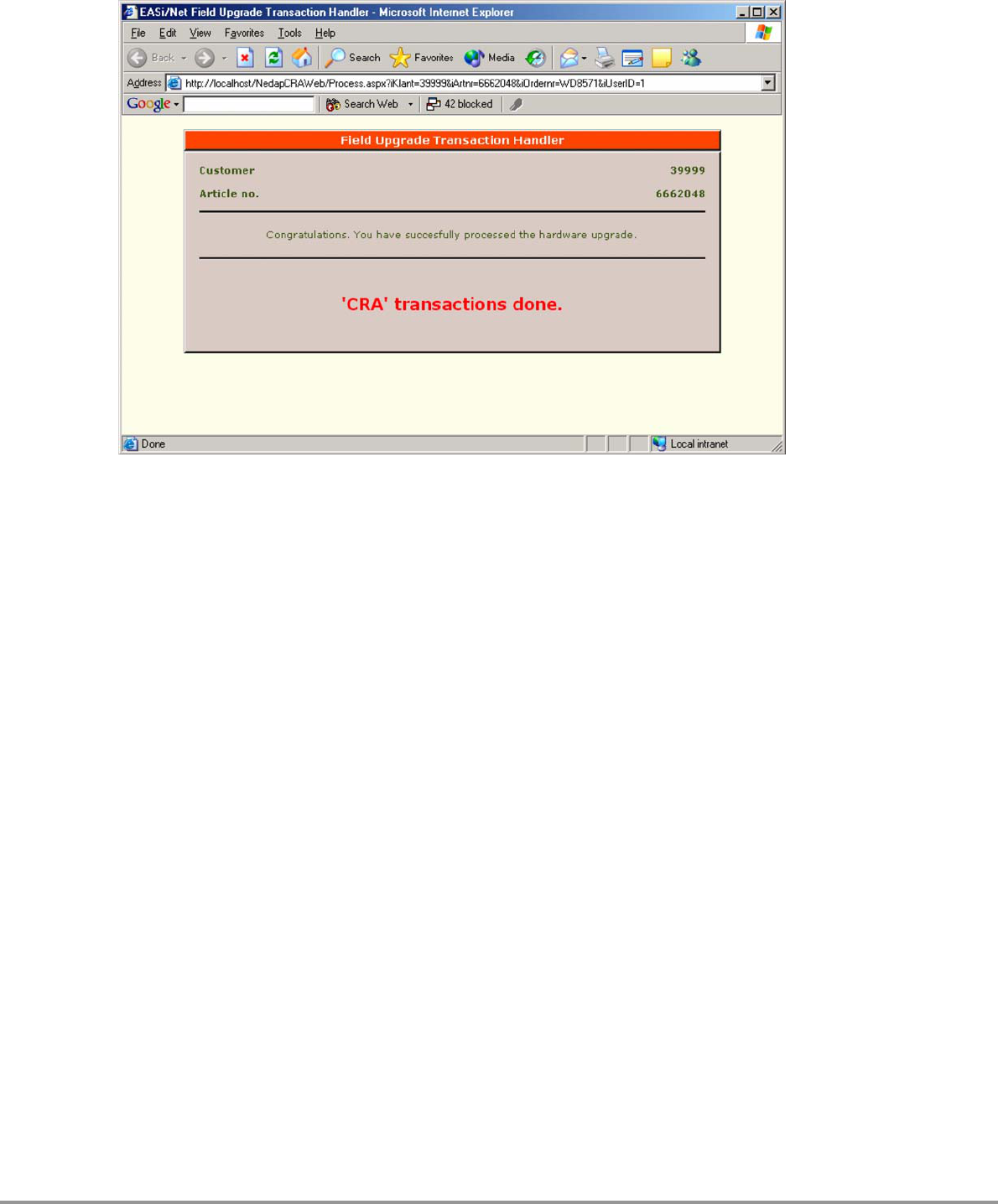
19
TDC 2004 V1.20 | Nedap Retail Support

20
TDC 2004 V1.20 | Nedap Retail Support
3.7 The Functionality Modules
AEM= Aisle Extension Module
(IQ) Extend the antenna-outputs with one aisle
CCM= Customer Counting Module
(IQ) Collect the Customer Counting data on the EASi/Net
CEM= Channel Extension Module
(TDC) Extend the channels of the TDC with one channel
CRA= Challenge - Response - Acknowledge
DCM= Data Collection Module
For collecting data from the system into the EASi/Net
IOM= Input - Output extension Module
NCM= Network Connection Module
Bridging between the units
RSM= Remote Service Module
Module for remote service of the system

21
TDC 2004 V1.20 | Nedap Retail Support
Like the other OS/T electronics, remote servicing, is available. Through the integrated
RS232 connector it is possible to control and service the TDC. It is also possible to
update the firmware or to upgrade Functionality Modules by internet.
Full OS/T-builder compatibility for remote diagnostics and adjustments:
- Detection sensitivity
- Deactivation power
- Remote on/off
- Output/ input settings
- Q-factor level hard-/paper tag detection
- Tag detection and deactivation statistics like Q-factor, frequency, FTD’s
4. Remote servicing

22
TDC 2004 V1.20 | Nedap Retail Support
When having a modem connected to the TDC it is easy to monitor deactivations and
tagging efficiency & tag quality control and more.
5. EASi/NetTM

23
TDC 2004 V1.20 | Nedap Retail Support
The TDC is suitable for various deactivator antennas.
Powersplitter 4x Powersplitter 4x
TDC Standalone
7. Antennas
24
TDC 2004 V1.20 | Nedap Retail Support
There are In- and outputs for easy connection to POS (Point Of Sales), Nedap web
detachers, cameras, etc.
Version A
Connector K10
1 Relay2 C
2 Relay2 NO
3 Relay2 NC
4 Relay1 C
5 Relay1 NO
6 Relay1 NC
7 +6 Volt DC
8 Aux2 in (counting detacher)
9 Aux1 in (counting detacher)
10 Opto1 in(+)
11 Opto2 in(+)
12 Opto 1 and 2 Common (-)
13 I2C Sda
14 I2C Scl
15 +33Volt
16 Gnd
AUX1,AUX2 in specs
Both inputs have internal pull-up resistors and can work with a switch to ground
In case of an active input signal: Max input voltage 6V.
Opto 1,2 specs
Input voltage between 5V dc and 33V dc
8. Inputs / Outputs
25
TDC 2004 V1.20 | Nedap Retail Support
Version B
Connector K10
1 Relay2 C
2 Relay2 NO
3 Relay2 NC
4 Relay1 C
5 Relay1 NO
6 Relay1 NC
7 Aux2 in (counting detacher)
8 Aux1 in (counting detacher)
9 Opto1 in(+)
10 Opto1 in(-)
11 Opto2 in(+)
12 Opto2 in(-)
13 I2C Sda
14 I2C Scl
15 +33Volt
16 Gnd
Connector K12 (counting detacher)
1 +33Volt
2 Aux2 in
3 Gnd
Connector K13 (counting detacher)
1 +33Volt
2 Aux1 in
3 Gnd
AUX1,AUX2 in specs
Both inputs have internal pull-up resistors and can work with a switch to ground
In case of an active input signal: Max input source current 10 mA or max input voltage
6V.
Connector K10 pin 7,8 and Connector K12,13 are in parallel, only one can be used at a
time.
Opto 1,2 specs
Input voltage between 5V dc and 33V dc